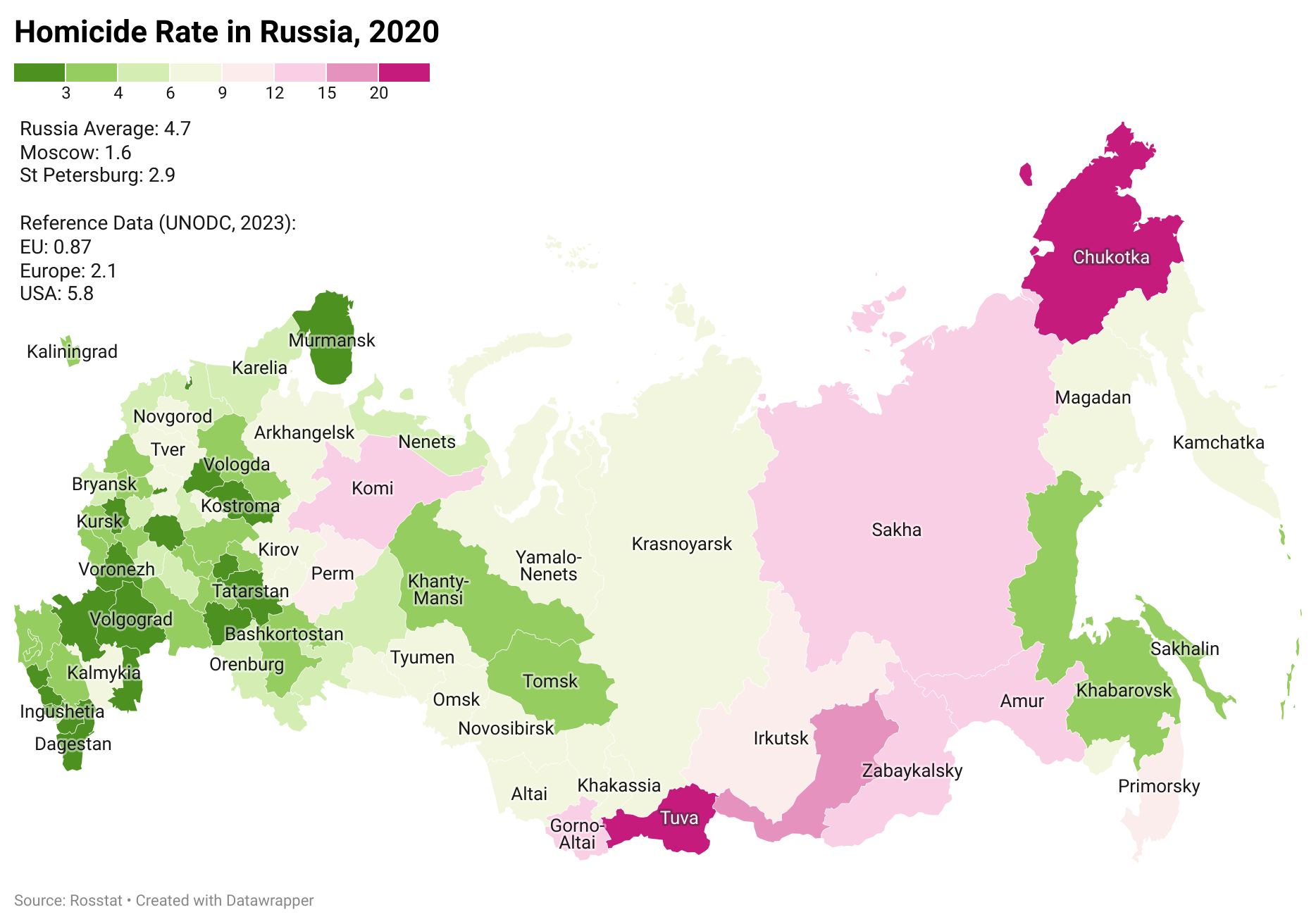Homicide Rates in Russia by Regions Map


Marcus Rodriguez
Historical Geography Expert
Marcus Rodriguez specializes in historical cartography and geographic data analysis. With a background in both history and geography, he brings unique...
Geographic Analysis
What This Map Shows
The "Homicide Rates in Russia by Regions, 2020" map provides a visual representation of the varying homicide rates across different regions of Russia during that year. This kind of cartographic visualization is essential for understanding the complexities of crime and safety in such a vast nation. As we delve deeper into the topic of homicide rates, it’s crucial to recognize that these figures are not just numbers; they reflect societal issues, law enforcement effectiveness, and economic conditions.
Deep Dive into Homicide Rates in Russia
Homicide rates are a critical indicator of public safety and social stability in any country. In Russia, the rates of murder and manslaughter can fluctuate significantly from one region to another, influenced by a multitude of factors such as socio-economic conditions, urbanization, and even cultural norms. In 2020, the overall homicide rate in Russia was approximately 8.2 per 100,000 people, a figure that has seen a decline compared to previous decades, but still raises concerns in certain areas.
Interestingly, the reasons behind these rates can be quite complex. In urban centers such as Moscow and St. Petersburg, the homicide rates tend to be lower due to better law enforcement and access to resources. However, in more remote or economically depressed regions, such as the North Caucasus, the rates can be significantly higher. For instance, Chechnya and Dagestan have been reported to have homicide rates that exceed the national average, often attributed to longstanding conflicts, socio-political instability, and organized crime.
Moreover, factors such as alcohol consumption, which is prevalent in many parts of Russia, significantly contribute to violent crime, including homicides. The correlation between alcohol-related incidents and homicide rates is well-documented; in 2020, many homicides were reported to occur in domestic settings, particularly involving intoxicated individuals. The Russian government has implemented various measures over the years to combat alcohol abuse, but the cultural factors surrounding alcohol consumption remain a challenge.
In addition to socio-economic and cultural influences, the legal context and law enforcement practices also play crucial roles in shaping homicide rates. Regions with effective policing and judicial systems are often able to deter violent crime more successfully than those with less robust institutions.
Regional Analysis
When examining the map of homicide rates in Russia by region, we can see distinct patterns emerge. For example, the Siberian regions, while vast and sparsely populated, show varying homicide rates that can be attributed to their socio-economic conditions and geographic isolation. Regions like Irkutsk and Altai Krai report higher rates compared to others, potentially linked to poverty and limited access to social services.
Conversely, the western regions, including Tatarstan and Bashkortostan, tend to report lower homicide rates. These areas benefit from a more stable economic environment and have made strides in improving law enforcement and community safety. Interestingly, the Volga Federal District, which includes several of these regions, has seen a concerted effort to reduce crime rates through community policing and social programs, resulting in a noticeable decline in homicides.
Another point of interest is the impact of the geographical landscape on crime. Urban areas have different crime dynamics than rural areas. For instance, while the urbanized centers may experience lower homicide rates, they often face other forms of crime and violence, such as gang-related activity. In contrast, rural regions might not only have higher homicide rates but also face challenges related to underreporting due to a lack of resources.
Significance and Impact
Understanding homicide rates in Russia is crucial for several reasons. Firstly, it provides insights into the effectiveness of law enforcement and social policies. High homicide rates can indicate systemic issues that require attention, such as poverty, lack of education, and inadequate access to healthcare. These factors can perpetuate a cycle of violence that affects communities at multiple levels.
Moreover, policymakers can use this data to allocate resources more effectively, targeting regions that need intervention the most. As Russia continues to grapple with issues of crime and public safety, the importance of localized data cannot be overstated. Additionally, with ongoing geopolitical tensions and social changes within the country, monitoring these rates will be vital for future planning and stability.
In conclusion, the "Homicide Rates in Russia by Regions, 2020" map offers more than just statistics; it opens up a dialogue about the underlying factors influencing crime in one of the world's largest countries. As we look toward the future, understanding these patterns will be essential for fostering safer communities and informed policy decisions.
Visualization Details
- Published
- October 22, 2025
- Views
- 30
Comments
Loading comments...